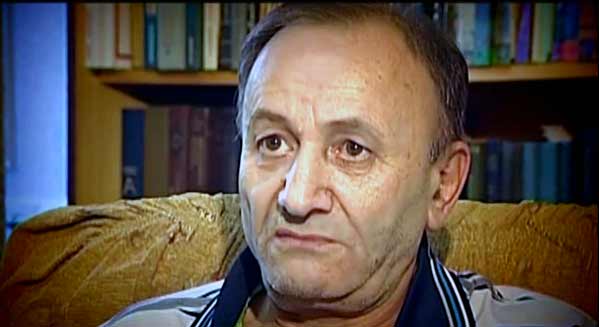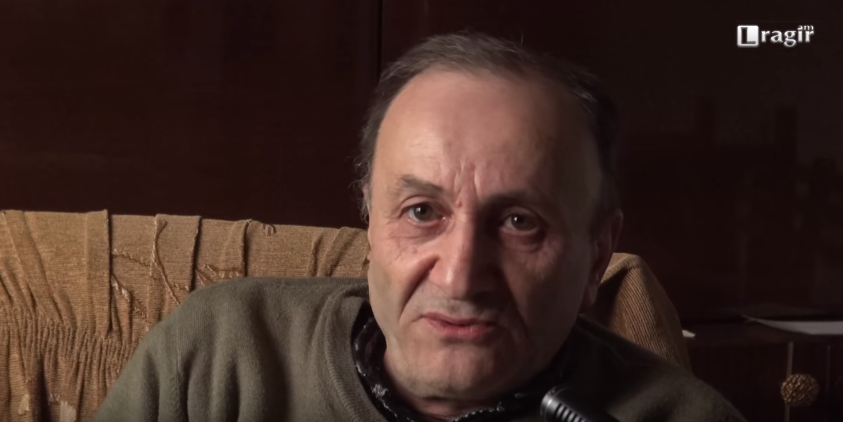Quarterly Report on the Human Rights Situation in the Armed Forces / Vol.6
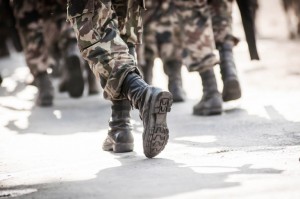
October-December 2017
Peace Dialogue is presenting the current issue of its quarterly report on the conditions of Human Rights in the RA Military Forces. Peace Dialogue is an Armenian non-governmental organization active in peace building, democracy and human rights. One of the main spheres of its activities is monitoring of human rights violations in the RA Armed Forces, in pursuit of justice and initiation of public debate on current issues in the Armenian Armed Forces, particularly aimed, but not limited to, at seeking relevant solutions and promoting those solutions by presenting them to the Armenian authorities and relevant international actors.
This report includes the latest analysis and covers the following topics:
- Fatal incidents in the Armenian and NK Armed Forces for 2010-2017;
- Health checkups for conscription and medical examination;
- In Armenia conscripts aged 18-27 are forbidden to leave the country without providing military service record books;
- Information related to the investigation of the death of soldier David Terteryan;
- Information related to the investigation of private soldiers Grigor Avetisyan’s and Souren Aramyan’s death cases;
- Update on the court case of the death of Private Manuchar Manucharyan;
- Update on the court case of the death of Private Haroutyun Hambaryan.
1. Fatal incidents in the Armenian and NK Armed Forces for 2010-2017
The number of losses in the armed forces is reduced in official sources
The only official statement available for the organization about the death cases registered in the RA Armed Forces in 2017 was in an interview given by the RA Military Prosecutor, Deputy Prosecutor General Vahe Harutyunyan on December 29, 2017, in which he said that 23 soldiers died in 2017 as a result of a ceasefire regime violation by the adversary, while the number of non-combat fatalities was 29. Thus, according to Mr. Harutyunyan the total number of fatalities in 2017 was 52.
In 2017, Peace Dialogue NGO received information about 59 fatalities in the RA and NK armed forces: 6 cases of murder, 8 cases of suicide, 22 cases that were the result of ceasefire regime violation, 3 cases that were the result of negligence, 3 cases that were the result of health problems, 3 cases that were the result of safety rules violation and 5 more cases the causes of which are yet unknown.
All the cases are posted on Peace Dialogue NGO’s website www.safesoldiers.am. The website also includes all the fatalities recorded in the RA and NK armed forces since 1994 that the organization was able to find information about, including their descriptions and information about the deceased soldiers. There are a number of sources for the data posted on the website, such as information published by different media outlets, facts posted by the citizens about their relatives, as well as information provided by partner organizations and their analysis. The database therefore is still a work in progress, since the Ministry of Defense and other authorities constantly refuse to provide information to the organization regarding these tragic incidents.
Almost the same number is repeated in the statements and publications of other Armenian organizations that monitor the situation, for example, HCA Vanadzor recorded 60 cases of death. [One of the cases concerns the death of Mayis Geghamyan, who died in the hospital on June 3, 2017 (during healing of osteogenic sarcoma caused by physical injury the soldier received during military service in 2013).]
Despite this, in the above interview, Harutyunyan recorded a decrease in death cases.
Comparing the number of cases in 2015, 2016, 2017 that are not related to the border incidents and clashes, the military prosecutor declared that 31 cases of death were registered in 2015 (37 according to the data by safesoldiers.am), 47 (60 by safesoldiers.am) cases in 2016, and 29 (37 by safesoldiers.am) cases in 2017.
No measures are taken to reduce the number of non-combat deaths in the army
The examination of the data of registered deaths on www.safesoldiers.am for the period 2010-2014 (even considering the lack of official data and the difficulties of collecting data from other sources, nevertheless this information can be considered relatively complete statistics for 2010-2017), shows that the total number of registered losses on the website for the reporting period is 531:
As it can be observed in the following table, during the last eight years 235 servicemen died as a result of the ceasefire violation and 296 soldiers lost their lives mainly due to internal factors in the army, such as murders and suicides, as well as negligence that resulted in accidents or deaths of soldiers recruited to the army with health problems.
It should be noted that most of the cases posted on the website are based on the official data. That is why, in some cases, the real causes of the deaths of soldiers remain unknown to the public (for example, the murder cases may be presented as a result of violation of the ceasefire regime).
Year |
M |
VSR |
HI |
FA |
S |
CRV |
N/I |
Other |
Σ |
| 2010 | 16 | 1 | 13 | 12 | 7 | 11 | 1 | 0 | 61 |
| 2011 | 6 | 1 | 4 | 8 | 10 | 11 | 1 | 0 | 41 |
| 2012 | 5 | 2 | 5 | 14 | 13 | 12 | 3 | 0 | 54 |
| 2013 | 5 | 1 | 5 | 8 | 8 | 5 | 0 | 0 | 32 |
| 2014 | 5 | 4 | 3 | 5 | 8 | 26 | 0 | 0 | 46 |
| 2015 | 6 | 0 | 4 | 20 | 7 | 39 | 0 | 0 | 76 |
| 2016 | 7 | 4 | 2 | 14 | 13 | 109 | 1 | 12 | 162 |
| 2017 | 6 | 3 | 3 | 9 | 8 | 22 | 3 | 5 | 59 |
| Σ | 56 | 16 | 39 | 90 | 69 | 235 | 9 | 17 | 531 |
- M – Murder
- VSR – Violation of safety rules;
- HI – Health issues;
- FA – Fatal accidents
- S – Suicide
- CRV – Ceasefire regime violation
- N/I – Negligence/Inaction
Nonetheless, based on data recorded on www.safesoldiers.am, it becomes clear that there were more losses in 2010-2017:
- Ceasefire regime violations (235 cases),
- Fatal accidents (90 cases),
- Suicides (69 cases),
- Murders (56 cases),
- Health issues that resulted in death ( 39 cases),
- Violation of safety rules (16 cases) ,
- Official inaction and negligence that result in death (9 cases)
The organization has not been able to verify the information about the death of 17 soldiers.
The graphic below demonstrates the dynamics of deaths by years.
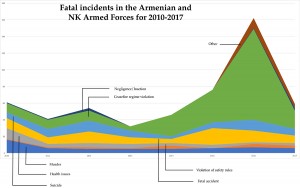
As you can see from the picture, over the past eight years the least number of losses were recorded in 2013 (32 people), and the maximum number was recorded in 2016 (162). It is noteworthy that the number of casualties in the ceasefire regime increased every year throughout the period 2013-2016, while in 2016 an unprecedented increase was recorded because of the April war [According to the Helsinki Citizens’ Assembly Vanadzor Office, for example, the number of victims was 175 in 2016, however, Peace Dialogue NGO has not found any information about the 13 victims mentioned by the HCAV in other sources available to organization, including the official sources.]
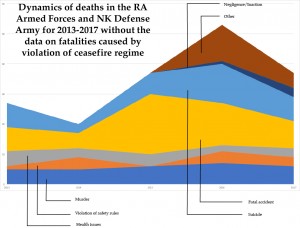
It is also clear that since 2013 the number of deaths that were the result of suicides, fatal accidents, health issues, and negligence has grown almost simultaneously with the number of deaths caused by ceasefire regime violations.
It seems that these high rates of mortality during military service should have become a serious issue of concern for the officials responsible for the sector.
It was expected that the actions aimed at reducing non-combat losses should have been prioritized in the documents defining the policy of the defense sector, however, despite persistent calls and suggestions by the civil society representatives, no direct action was enforced in this regard in the Plan of Action for the National Strategy on Human Rights protection 2017-2019. No preventive actions were introduced in the concept of “Nation-Army” presented to the public in 2017 and in the RA draft law on Military Service and the Status of Military Serviceman presented in the framework of the same concept.
2. Health checkups for conscription and medical examination
In this issue of the report we touch upon the analysis of the article “Health checkups for conscription and medical examination” of the RA draft law on Military Service and Status of Servicemen presented in the framework of the concept of “Nation-Army” proposed by the RA Ministry of Defense.
The aim of the analysis is to find out what mechanisms the draft law provides for the conscripts who are “fit for military service with restrictions” due to health issues for finding out information about their military service before being drafted to the army. Particularly, the mechanisms that help them to find information about the specific aspects of military service that are contraindicated in those servicemen because of their health issues or the exact restrictions of service that are envisaged based on the health condition of the serviceman.
It should be noted that in our previous issue of report for the period April-June 2017 we presented our analysis on “The ambiguity of the terms “suitable for military service” and “suitable with restrictions” in the RA law”.
In that analysis we expressed our concern over the fact that many relatives of those citizens who underwent/are undergoing compulsory military service in the Armenian Armed forces applied to the organization during the period of 2015-2017 and pointed out that, despite the fact that their children were deemed suitable for “military service with restrictions” after a health check, they were/are not granted any privileges and it is unclear how mentioned restrictions effect their children’s service.
According to the existing legislation, the list of diseases is defined by the order 410-N of the Minister of Defense of the Republic of Armenia, while the characteristics of military service restrictions, permitted physical exercises and the restrictions on the appointment of military servicemen are defined by the secret order of the Chief of the General Staff of the RA Armed Forces.
In September 2017, the HCA Vanadzor filed a lawsuit to the Administrative Court requesting the copy of the characteristics of the military service restrictions and the handbook approved by the decree of the Chief of the General Staff of the Armed Forces on January 15, 2014.
During the court hearing the representative of the Ministry of Defense announced that the handbook will be available on the arlis.am system in the form of an application of MoD order N 410 dated 04.08.2013, however it has not been done yet. On December 21, 2017 the court was supposed to announce the verdict, but as a result a decision was made not to issue it and continue the trial.
According to the RA draft law on the Military Service and Status of Servicemen, which was adopted by the National Assembly in the second reading in November,2017, “the procedure for examining the health condition of the conscripts and servicemen, the list of diseases according to which the degree of fitness of conscript or military serviceman to military service is determined, as well as the conditions of the military service that contravene the health condition of the conscripts or the servicemen, shall be defined by the Government of the Republic of Armenia”.
According to Article 17, paragraph 4 of the draft law, the Medical Commission shall draw a conclusion on the health condition of the conscript, which shall include a summary of the health condition of the conscript and the degree of fitness of the conscript to the military service. According to the draft, depending on the degree of fitness of the conscript to military service, the report on the state of conscript’s health may state the following:
1) fit for military service or for studying at a military educational institution;
2) fit for military service with restrictions;
3) temporarily unfit for compulsory military service;
4) in peaceful conditions is not fit for military service;
5) in peaceful conditions and during military service is not fit for military service;
6) is not fit for studying at a military educational institution;
7) needs medical treatment;
8) is not subject to call-up and military training.
It should be noted that, as in the current law, the new draft law does not specify as to how the servicemen who were drafted with restrictions to military service can get acquainted with the restrictions of military service that are contraindicated in their health, or what kind of limited service is envisaged for them due to their health condition. If this issue is not regulated by other legal acts, the possible abuses of the unscrupulous command staff may continue in this regard: because of conditions of military service contraindicated in those servicemen and inadmissible physical exercises, the health and life of soldiers undergoing military service with the conclusion “fit for military service with restrictions” will be in danger.
Peace Dialogue NGO will try to receive explanations from the Ministry of Defense about prospects of regulating the issue with other legal acts and the organization will provide further update on this issue.
3. In Armenia conscripts aged 18-27 are forbidden to leave the country without providing military service record book.
According to different articles circulating in the Armenian media, on December 28, 2017 male citizens of Armenia aged 18-27 were not allowed to board on the planes at Zvartnots airport. This was substantiated by the decision N 1386 of the RA Government of Armenia in 2017.“According to this decision, in order to prevent cases of possible avoidance of conscription, the Armenian male citizens of conscription age are allowed to leave the country only if in their military service record booklets it is mentioned that they have completed military service or they are listed in the reserve due to illness, or in case of presence of appropriate marks in the certificates of attachment (preliminary registration of citizens where it is mentioned which unit they will be attached to in case of war) by the military commissariat on the right of deferment from mandatory military service recruitment “.
Peace Dialogue NGO considers that action a violation of the right to free movement by preventing citizens from departing with only providing this kind of justification. According to Article 13 of the Universal Declaration of Human Rights, everyone has the right to go anywhere, including the right to leave his/her own country.
No restrictions shall be imposed on the exercise of this right with the exception of cases that are prescribed by law and are necessary in a democratic society in the interests of public safety, for the protection of public order, health or morals, or the protection of the rights and freedoms of others.
This right may also be subject to restrictions in certain areas, in accordance with the law, and if that limitation is justified by the public interest of a democratic society.
As stated above, the restriction of this right can only be by law, but not by a lower legal force, such as the Government’s decision.
In the case of restricting the right of a citizen, it is necessary for the State to provide substantiated arguments that restricting a particular citizen’s movement is a necessary measure for national security or public safety, public order, crime prevention, health or morals, or the protection of the rights and freedoms of others.
Additionally, there is a need for the State to provide substantiated arguments that such a restriction arises from the public interest of a democratic society.
Even if we consider that this restriction was a legally grounded step, people have not been properly informed about the amended procedure; therefore, they were not obliged to take with them their military record book for crossing the border when they came to the airport. A military booklet is just a document certifying the relation of the person to the military service, not a required document for crossing the state border.
In this regard, Peace Dialogue NGO has issued a statement calling upon all those, whose departure was hindered by the above-mentioned reason, contact the organization to appeal the legality of the action.
4. Information related to the investigation of the death of soldier David Terteryan
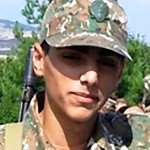 According to the statement issued by the RA Investigative Committee, at 1:00p.m on February 8, 2016 the body of private Davit Terteryan was found in the defense area of N military unit with a fatal gunshot wound to his head.
According to the statement issued by the RA Investigative Committee, at 1:00p.m on February 8, 2016 the body of private Davit Terteryan was found in the defense area of N military unit with a fatal gunshot wound to his head.
Based on the preliminary investigation of the scene and the body, a criminal case was initiated at the first Garrison Investigation Division with the features of causing someone to commit suicide.
After being acquainted with the materials of the investigations carried out so far, the representative of the victim’s successor, Peace Dialogue Expert R. Martirosyan found out the following:
- The facts of the case affirm that Tertertyan’s fellow soldier S. Hamazaspyan, while performing his duties as a senior of the post, abused his official position and during the period January-February 2016 periodically tried to suppress and humiliate D. Terteryan. Eventually when he subjected Terteryan to violence, he received a worthy rebuff. The staff of Stepanakert’s Militray Police department were aware of this situation, but they did not take any steps and did not punish Hamazaspyan, which resulted in the murder of Terteryan;
- According to defender Hamazaspyan’s testimony and explanations, he was the first to hear gunshot from the military base (where Terteryan was at that moment) and he was the first to go to the base and find Terteryan dead. As Hamazaspyan pointed out, “he was shot in the head”;
- The testimonies of Hamazaspyan and those of six other servicemen of the base contradict each other:
a. Traces of copper were found on the faces of all the servicemen that were in the base which implies that they were all in the same area as Terteryan when the gunshot was fired.
b. The traces of antimony have been found on the right arm of Hamazaspyan’s winter uniform. It should be noted that the so-called “antimony” metal does not exist in nature; it emerges from the firing of gunpowder during the shooting. This fact is an unquestionable proof that Hamazaspian was at the scene and apparently, he was the one who killed Terteryan; - After the incident the soldiers of the base led by their senior commander destroyed the scene and removed the corpse from the scene. The investigator takes into account not the forensic expert’s examination, according to which immediately after Terteryan received a gunshot wound on the head he died, but the testimonies of the soldiers of the base, according to which after the gunshot allegedly Terteryan was still alive for a while.
5. Information related to the investigation of private soldiers Grigor Avetisyan’s and Souren Aramyan’s death cases
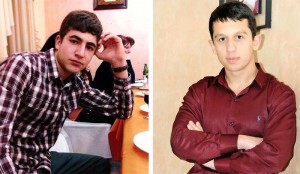 According to the preliminary investigation, based on the phone-book brought to the RA IC 5th garrison investigative division on April 6, 2016, on April 5, 2016 at about 2:30-3:00 a.m. privates Grigor Avetisyan and Suren Aramyan of the RA MoD N28418 military unit received fatal gunshot wounds at the artillery firing range of the N 75937 unit and died immediately. Meanwhile, privates of the same military unit Hakob Gevorgyan and Areg Baghdasaryan received gunshot wounds to the lower limbs.
According to the preliminary investigation, based on the phone-book brought to the RA IC 5th garrison investigative division on April 6, 2016, on April 5, 2016 at about 2:30-3:00 a.m. privates Grigor Avetisyan and Suren Aramyan of the RA MoD N28418 military unit received fatal gunshot wounds at the artillery firing range of the N 75937 unit and died immediately. Meanwhile, privates of the same military unit Hakob Gevorgyan and Areg Baghdasaryan received gunshot wounds to the lower limbs.
It should me noted, that in March 2017, the investigator of the case made a decision to divide the criminal case into two separate cases and then sent G. Avetisyan’s murder case to court. The aggrieved party managed to receive the copy of this decision only in May and sent a complaint.
The Prosecutor’s office and the Investigative Committee failed to answer the complaint in the established order.
The complaint against this inaction was sent to the Court of General Jurisdiction of Arabkir and Kanaker-Zeytun administrative districts. Although it has been 5 months since the complaint was sent, the court continuously delays the court hearings and so far, no court session has ever taken place to hear the complaint. At the same time, the investigative body constantly invites H. Avetisyan, the father of one of the killed soldiers, threatening to detain him in case he refuses to come.
Whereas several months ago H. Avetisyan gave a testimony on the case initiated under false accusation and exhaustively answered all the questions of the investigator.
6. Update on the court case of the death of Manuchar Manucharyan
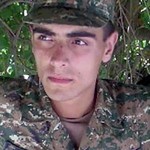 According to the statement issued by the Ministry of Defense, on July 31, 2013 at approximately 1:40 pm. Private Manuchar Manucharyan while on service on the watchtower, shot himself to death with the AKS-74 rifle attached to him.
According to the statement issued by the Ministry of Defense, on July 31, 2013 at approximately 1:40 pm. Private Manuchar Manucharyan while on service on the watchtower, shot himself to death with the AKS-74 rifle attached to him.
A criminal case was initiated in the RA MoD Investigative Service under Article 110, Part 1 of the RA Criminal Code (causing somebody to commit suicide).
On November 2, 2017 the RA Criminal Court of Appeal heard the complaint of the aggrieved party and that of the defender’s lawyer against the verdict of A. Mkrtchyan, the Judge of the Court of First Instance of Arabkir and Kanaker-Zeytun Administrative Districts.
It should be noted that rejecting the motion of the parties, the judge considered it a proven fact that M. Manucharyan committed suicide and sentenced the defendants Gaboyan and Stepanyan to imprisonment for different periods.
The first complaint was presented by the aggrieved party to the Court of Appeal.
The representative of the agrrieved party, Peace Dialogue expert R.Martirosyan reported a crime against a number of officials who are involved in Manucharyan’s murder case in one way or another and petitioned the court to transfer his report to the relevant authorities.
The defense drew attention to the contradictions in witness testimonies, as well as the statements made by witnesses in the court that their testimonies had been extorted from them. Meanwhile, R. Martirosyan drew the court’s attention to another fact: on the right thigh area of Manuchary Manucharyan’s trousers, the invetigator found and recorded a 5mm diameter round hole on the pants with traces of burn on the edges.
In the First Instance Court the aggrieved party announced that the damage on the trousers was a result of a gunshot and which, in fact, is an undeniable proof that M. Manucharyan was killed.
R. Martirosyan mentioned that he had reported on the crimes committed by the experts who concealed this fact and said that the preliminary investigation body had to examine the appeal titled “Report on crime” and either reject it or start a legal process, so that the court of first instance starts the proceedings together with the criminal case.
Presiding Judge Mkrtchyan, however, did not refer to this document in his verdict at all.
Moreover, the Judge rejected the aggrieved party’s motion to send the trousers for a new expert examination to determine the origin of the damage on them and the period of limitation. In his decision to refuse the motion of the injured party, the judge stated the he will refer to the contradiction regarding the trousers in his verdict, however nothing is mentioned about this in the verdict.
Based on the foregoing, the aggrieved party motioned for an acquittal verdict on the case of suicide and sending the case back for investigation.
Prosecutor Amiryan petitioned the court to reject the motion of the aggrieved party, justifying it with the following factors:
a) The forensic examination of M. Manucharyan’s body revealed no injury in his right thigh.
b) The trace and ballistic examinations of Manucharyan’s clothes found no damages on Manucharyan’s trousers.
The investigation is underway.
7. Update on the court case of the death of Private Haroutyoun Hambaryan
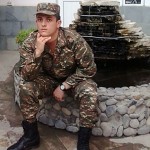 A criminal case was initiated in the 3rd garrison Investigation Division of the General Investigation Department of the RA Investigation Committee on the death of conscript Haroutyoun Hambaryan.
A criminal case was initiated in the 3rd garrison Investigation Division of the General Investigation Department of the RA Investigation Committee on the death of conscript Haroutyoun Hambaryan.
According to the preliminary information, on May 8, 2015 at approximately 3:15p.m. Haroutyoun Hambaryan, private soldier of N military unit of NK Defense Army died on the spot as a result of a gunshot fired onto the front part of his head from a gun attached to him. The investigation of the case continues with the hypothesis of “suicide”.
The investigation continues to be carried out by the same investigative division that has previously “proved” that H. Hambaryan committed suicide without any reason.
As a reminder, H. Hamaryan’s case was terminated in 2016 with a hypothesis of “suicide”, whereas after the court eliminated the decision on terminating the case, the preliminary investigation body continues to examine the case under the same hypothesis of suicide, despite all the evidence that it was a murder.
Several months ago, Judge D. Sargsyan started the examination of the aggrieved party’s appeal, although with a one-year delay, and made a decision on questioning a number of servicemen, conducting a number of other investigative actions and appointing expert examinations.
However, now the Judge announces that the defense party motioned for an accelerated trial, therefore if the aggrieved party does not appear at the court session, the Court will satisfy the motion that implies that the two defendants accused of suicide admit their guilt and the trial ends with it.
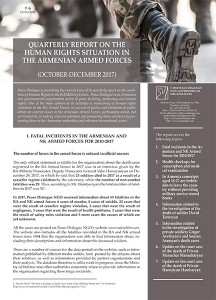 Download Quarterly Report on the Human Rights Situation in the Armenian Armed Forces/Vol.6 (Period: October -December, 2017) (Version: pdf, 377 kB)
Download Quarterly Report on the Human Rights Situation in the Armenian Armed Forces/Vol.6 (Period: October -December, 2017) (Version: pdf, 377 kB)
Posted 09 April, 2018


